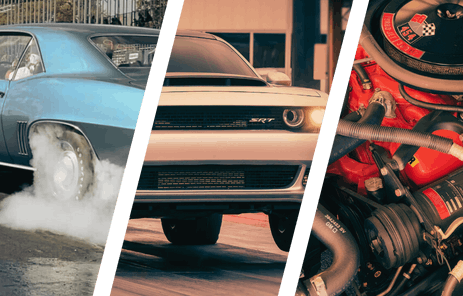
Welcome back to the second installment of Rod Authority’s Trivia Tuesday. In this installment we’re going to discover some more firsts, like what firsts did the Plymouth Valiant gave us, what car gave us the first replaceable cartridge oil filter, and a couple more items of automotive trivia. Without further ado, let’s dive into the Tuesday trivia pool:
What Car Had the First Oil Filter with a Replaceable Cartridge?

This one has been making the rounds of social media of late. However, the answer given is extremely basic: The car that had the first replaceable cartridge oil filter was the 1924 Chrysler. Nobody mentions the engine, other than to say it had that replaceable cartridge filter, but they should because the ’24 Chrysler also had a couple of other firsts going for it.
It was advertised as having a compression ratio of a whopping 4.7:1, versus the standard 3.5: 1 in other makers’ engines, and it made a whopping 68 horsepower. It was also the first car to be produced with four wheel hydraulic brakes. Up until then the standard was two-wheel mechanical brakes.
From Birdcages to One of America’s Most Famous Automobiles

In the 1870s, the George N. Pierce Company was fairly well-known for making birdcages and household items such as iceboxes. A little while later, George saw this new contraption called a bicycle and used his expertise with metal tubing to start building bicycles. In the making of bicycles, George’s company is most well-known for innovations such as the cushion seat and coaster brakes.
In 1901, they transitioned into the newfangled contraption known as the motor-car, producing a one-cylinder automobile with a surrey/convertible top and bench seating for two. In 1908 they became the Pierce-Arrow Motor Car Company, and, as the saying goes, history was made. The world-famous Pierce-Arrow made its debut. These cars were the car of choice for the rich and famous for almost 38 years. Here’s another little piece of trivia for you: The Wright Brothers each owned a Pierce Arrow.
A Car with a Perpetual Guarantee? Too Bad the Company Folded So Soon!

The Acme Motor Car Company was active from around 1902 until about 1911/1912 (some records disagree). Over that time period they produced several different cars, such as the Touring Car pictured above, a Runabout, the Type XV Touring Car, the Type XX Touring Car, the “Quad” Type XXVII Runabout, and the Acme Special Sextuplet. None of these cars were much to write home about, even for the time. Their tagline was “The Acme-Justifies its name.” What was unique about these cars and the company was that they were the first to be offered with a “perpetual guarantee.” It’s just too bad the company folded so soon.
What Was the First Car to Be Advertised as a Convertible?

This is something of a tricky one, considering that the majority of cars produced up until the nineteen-teens were pretty much all convertibles. The thing is, none of them advertised themselves as convertibles. They were just motor-cars. Then along came the E.R. Thomas Motor Co. of Buffalo, New York and their 1904 Thomas Flyer. There was no convertible top frame on the car. That’s because this car was made with a removable hard top, similar to some other quite famous cars that came along about 50 years later from a different car maker halfway across the country. Notice the neat little chain drive on the side of this baby. The 1904 Thomas Flyer had a massive 750 cubic inch engine with a double chain drive. If it started raining while you were out for a drive with the top off, you got wet since it had no windshield.
More Firsts from the 1960 Plymouth Valiant

The Plymouth Valiant was conceived and designed under an uber-top secret project that was demanded by then Chrysler president Tex Colbert as a means of fending off the competition in the States and making inroads in markets around the world. The design team was led by Plymouth General Manager Harry Cheseborough and had approximately 200 engineers. Security on the project was so tight many thought it was for a government contract. For this and other reasons, some of which are mentioned below, it’s a trivia person’s dream car.

On top of being the first car to have an alternator instead of a generator, it also had upper and lower control arms of unequal length and coil springs and hydraulic shocks instead of torsion bars. The Valiant was one of the first cars to use computers to test its suspension for loads and stress. A computer was also used to design the vehicle for low noise, using the computers to find parts that rattled and vibrated.
It was equipped with a 276 cubic-inch Hemi engine with five mains and a cast-iron block and heads. It was also the first Chrysler model to make use of an integrated body and frame that was welded into a single solid structure, something that became standard practice for all Chryslers the next year.
You might also like
TMI Products Announces 2025 TRIM Awards Winners at SEMA
TMI Products has crowned the champions of the 2025 TRIM Awards at the SEMA Show. A 1969 International Scout took home the best reward.


